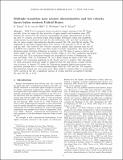| dc.contributor.author | Tauzin, B. | |
| dc.contributor.author | Wittlinger, G. | |
| dc.contributor.author | Ricard, Y. | |
| dc.contributor.author | van der Hilst, Robert D | |
| dc.date.accessioned | 2014-07-09T14:03:06Z | |
| dc.date.available | 2014-07-09T14:03:06Z | |
| dc.date.issued | 2013-05 | |
| dc.date.submitted | 2013-04 | |
| dc.identifier.issn | 21699313 | |
| dc.identifier.uri | http://hdl.handle.net/1721.1/88226 | |
| dc.description.abstract | With P-to-S converted waves recorded at seismic stations of the U.S. Transportable Array, we image the fine structure of upper mantle and transition zone (TZ) beneath the western U.S. We map the topographies of seismic discontinuities by stacking data by common conversion points along profiles. Systematic depth and amplitude measurements are performed not only for the well-known “410” and “660” interfaces but also for minor seismic discontinuities identified around 350, 590, and 630 km depths. The amplitude of conversion suggests shear wave velocity (Vs) increase by 4% at the 410 and the 660. The observed 660 velocity contrast is smaller than expected from the 6% in IASP91 but consistent with a pyrolitic model of mantle composition. The Gorda plate, subducted under northern California, is tracked to the TZ where it seems to flatten and induce uplift of the 410 under northern Nevada. Maps of 410/660 amplitude/topography reveal that the TZ is anomalous beneath the geographical borders of Washington, Oregon, and Idaho, with (1) a thickened TZ, (2) a sharp change in depth of the 660, (3) a reduced 410 conversion amplitude in the North, and (4) a positive “630” discontinuity. Such anomalous structure might be inherited from the past history of plate subduction/accretion. A thinned TZ under the Yellowstone suggests higher-than-average temperatures, perhaps due to a deep thermal plume. Both the “350” and the “590” negative discontinuities extend over very large areas. They might be related either to an increased water content in the TZ, a significant amount of oceanic material accumulated through the past 100 Myr, or both. | en_US |
| dc.description.sponsorship | National Science Foundation (U.S.) (VICI grant NWO:VICI865.03.007) | en_US |
| dc.language.iso | en_US | |
| dc.publisher | John Wiley & Sons, Inc | en_US |
| dc.relation.isversionof | http://dx.doi.org/10.1002/jgrb.50182 | en_US |
| dc.rights | Creative Commons Attribution-Noncommercial-Share Alike | en_US |
| dc.rights.uri | http://creativecommons.org/licenses/by-nc-sa/4.0/ | en_US |
| dc.source | van der Hilst via Michael Noga | en_US |
| dc.title | Multiple transition zone seismic discontinuities and low velocity layers below western United States | en_US |
| dc.type | Article | en_US |
| dc.identifier.citation | Tauzin, B., R. D. van der Hilst, G. Wittlinger, and Y. Ricard. “Multiple Transition Zone Seismic Discontinuities and Low Velocity Layers Below Western United States.” Journal of Geophysical Research: Solid Earth 118, no. 5 (May 2013): 2307–2322. | en_US |
| dc.contributor.department | Massachusetts Institute of Technology. Department of Earth, Atmospheric, and Planetary Sciences | en_US |
| dc.contributor.mitauthor | van der Hilst, Robert D. | en_US |
| dc.relation.journal | Journal of Geophysical Research: Solid Earth | en_US |
| dc.eprint.version | Author's final manuscript | en_US |
| dc.type.uri | http://purl.org/eprint/type/JournalArticle | en_US |
| eprint.status | http://purl.org/eprint/status/PeerReviewed | en_US |
| dspace.orderedauthors | Tauzin, B.; van der Hilst, R. D.; Wittlinger, G.; Ricard, Y. | en_US |
| dc.identifier.orcid | https://orcid.org/0000-0003-1650-6818 | |
| mit.license | OPEN_ACCESS_POLICY | en_US |
| mit.metadata.status | Complete | |
